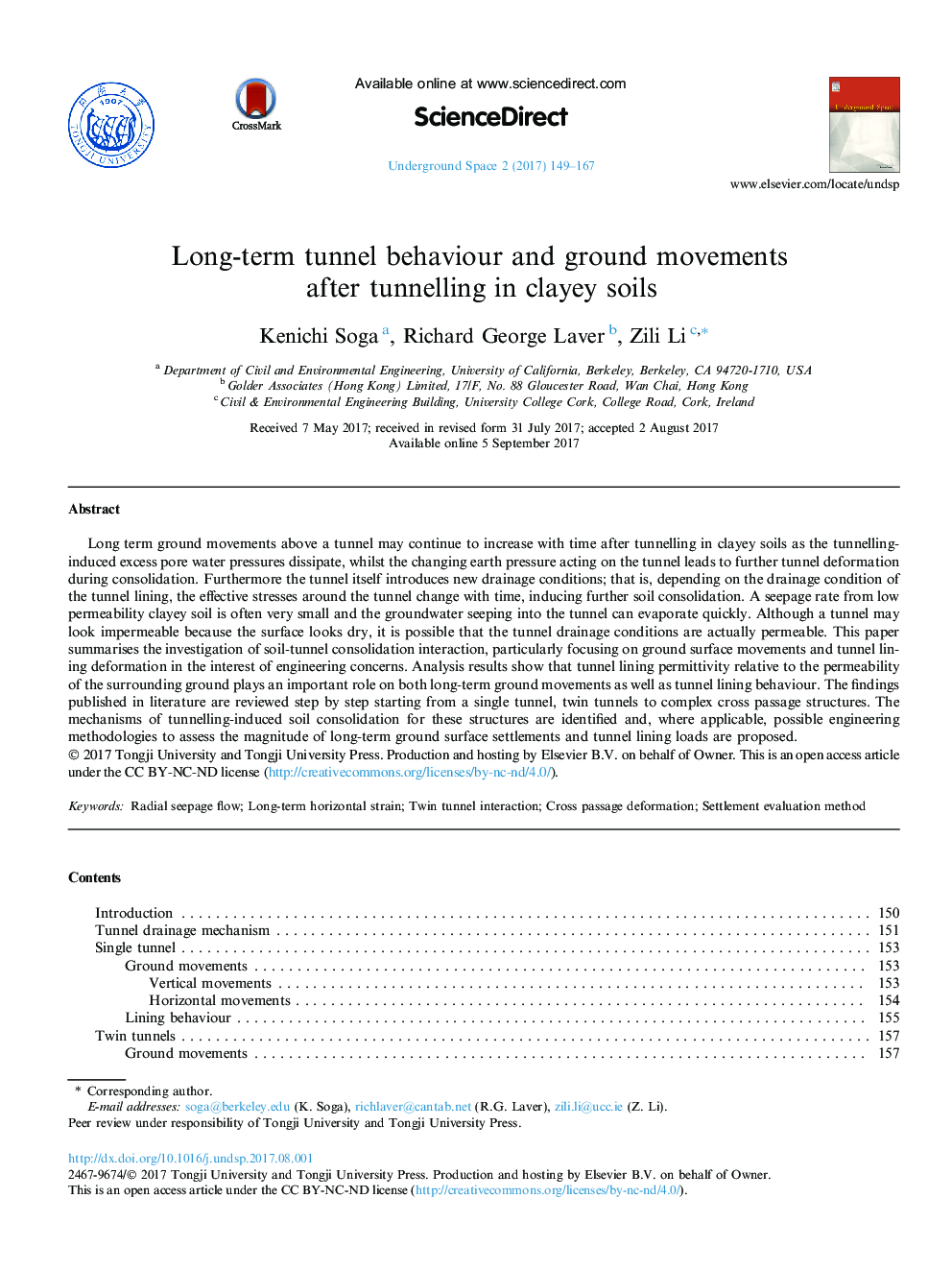| کد مقاله | کد نشریه | سال انتشار | مقاله انگلیسی | نسخه تمام متن |
|---|---|---|---|---|
| 6784393 | 1432327 | 2017 | 19 صفحه PDF | دانلود رایگان |
عنوان انگلیسی مقاله ISI
Long-term tunnel behaviour and ground movements after tunnelling in clayey soils
ترجمه فارسی عنوان
رفتار تونل دراز مدت و حرکات زمین پس از تونل شدن در خاک های خاکی
دانلود مقاله + سفارش ترجمه
دانلود مقاله ISI انگلیسی
رایگان برای ایرانیان
کلمات کلیدی
جریان شعاعی نفوذ، فشار افقی بلند مدت، تعامل دوگانه تونل، تغییر شکل عبور، روش ارزیابی حل و فصل،
ترجمه چکیده
حرکت طولانی مدت زمین در بالای تونل ممکن است پس از تونل شدن در خاک های خاکستری، همچنان افزایش یابد، زیرا فشار آب سطحی منافذ ناشی از تونل ها از بین می رود، در حالیکه تغییر فشار زمین در تونل باعث تغییر شکل تونل در طول تحکیم می شود. علاوه بر این تونل خود را معرفی شرایط زهکشی جدید. به عبارت دیگر، با توجه به شرایط تخلیه پوشش تونل، تنش موثر در اطراف تونل با زمان تغییر می کند و موجب تقویت بیشتر خاک می شود. نرخ نفوذ از خاک نفوذپذیری کم خاک بسیار خاکستری است و آبهای زیرزمینی به داخل تونل می توانند سریعا تبخیر کنند. اگر چه یک تونل ممکن است نفوذ ناپذیر باشد، زیرا سطح به نظر می رسد خشک است، ممکن است شرایط تخلیه تونلی در واقع نفوذ پذیر باشد. در این مقاله خلاصه ای از بررسی تعامل تثبیت خاک-تونل، به ویژه با تمرکز بر حرکات سطح زمین و تغییر شکل پوشش تونل در منافع نگرانی های مهندسی. نتایج تجزیه و تحلیل نشان می دهد که انعطاف پذیری تونل نسبت به نفوذپذیری زمین اطراف نقش مهمی در جنبش های بلند مدت زمین و همچنین رفتار تودل تونل ایفا می کند. یافته های منتشر شده در ادبیات گام به گام از یک تونل واحد، تونل دوقلو تا ساختار پیچیده عبور عبور می کنند. مکانیزم تثبیت خاک توسط تونل زنی برای این سازه ها شناسایی شده و، در صورت امکان، روش های مهندسی ممکن برای ارزیابی میزان سیگنال های بلند مدت سطح زمین و بارهای پوشش تونل پیشنهاد شده است.
موضوعات مرتبط
مهندسی و علوم پایه
علوم زمین و سیارات
مهندسی ژئوتکنیک و زمین شناسی مهندسی
چکیده انگلیسی
Long term ground movements above a tunnel may continue to increase with time after tunnelling in clayey soils as the tunnelling-induced excess pore water pressures dissipate, whilst the changing earth pressure acting on the tunnel leads to further tunnel deformation during consolidation. Furthermore the tunnel itself introduces new drainage conditions; that is, depending on the drainage condition of the tunnel lining, the effective stresses around the tunnel change with time, inducing further soil consolidation. A seepage rate from low permeability clayey soil is often very small and the groundwater seeping into the tunnel can evaporate quickly. Although a tunnel may look impermeable because the surface looks dry, it is possible that the tunnel drainage conditions are actually permeable. This paper summarises the investigation of soil-tunnel consolidation interaction, particularly focusing on ground surface movements and tunnel lining deformation in the interest of engineering concerns. Analysis results show that tunnel lining permittivity relative to the permeability of the surrounding ground plays an important role on both long-term ground movements as well as tunnel lining behaviour. The findings published in literature are reviewed step by step starting from a single tunnel, twin tunnels to complex cross passage structures. The mechanisms of tunnelling-induced soil consolidation for these structures are identified and, where applicable, possible engineering methodologies to assess the magnitude of long-term ground surface settlements and tunnel lining loads are proposed.
ناشر
Database: Elsevier - ScienceDirect (ساینس دایرکت)
Journal: Underground Space - Volume 2, Issue 3, September 2017, Pages 149-167
Journal: Underground Space - Volume 2, Issue 3, September 2017, Pages 149-167
نویسندگان
Kenichi Soga, Richard George Laver, Zili Li,
